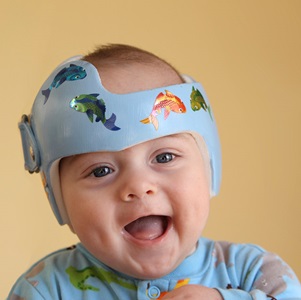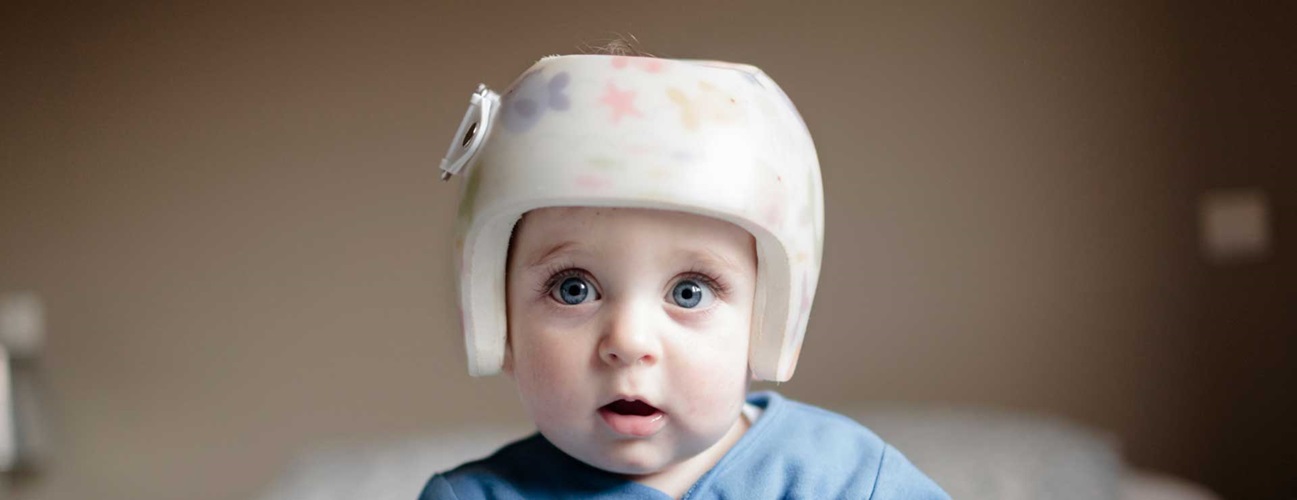Helmet Therapy for Your Baby
Helmet therapy is used to gently correct the shape of babies’ skulls over time. Newborn babies’ skulls are soft plates with spaces between them. As the baby grows, these plates grow, gradually harden and knit together.
Sometimes when a baby sleeps in the same position, the soft plates may develop a flat spot or uneven appearance. This common condition is called plagiocephaly, and it is not dangerous to your baby’s brain. If the condition does not resolve on its own, your pediatrician may recommend repositioning, exercises or helmet therapy.
In other cases, the plates of the baby’s skull fuse too soon, or in an abnormal way. This condition, craniosynostosis, can require surgical treatment with or without helmet in order to correct the head shape.
What You Need to Know

- Helmet molding therapy, or cranial orthosis, is a type of treatment in which a baby is fitted with a special helmet to correct the shape of the skull.
- Helmet molding therapy is not painful or uncomfortable for your baby.
- Duration of treatment can vary based on your baby’s needs, but average treatment is 3 months.
- Helmet therapy is also known as cranial orthosis.
How does helmeting correct my child’s head?
Cranial remolding helmets are usually made of a hard outer shell with a foam lining. Gentle, persistent pressures are applied to capture the natural growth of a baby’s head while inhibiting growth in the prominent areas and allowing for growth in the flat regions.
Adjustments are made frequently as your baby’s head grows. The helmet essentially provides a tight, round space for the head to grow into. Even if your child continues to rest his or her head on one side, the helmet will provide a cushioning to prevent the head from further flattening.
Is my child a candidate for helmet therapy?
If your child is diagnosed with deformational plagiocephaly, brachycephaly or scaphocephaly and is less than 12 months old, cranial remolding may be prescribed to correct the shape of the baby’s head. Helmets must be prescribed by a licensed physician. It’s important to note that not all infants are good candidates for helmet therapy, and it is important to discuss this with your doctor.
In addition, children who have undergone endoscopy to correct craniosynostosis will often be prescribed helmet therapy after surgery to further correct the shape of the head.
Does my child need to wear the helmet all day?
Yes. The idea behind the helmet is that it is worn 23 hours a day. It can be taken off during bathing. The rest of the time, your infant should constantly be in the helmet, whether playing, sleeping or feeding. This can be shocking to hear as a parent, as you think of your baby spending his or her formative months wearing a helmet. One thing we like to emphasize is that the helmet is usually not uncomfortable for the baby.
How long will my child wear a helmet?
The average treatment with a helmet is usually three months, but the duration of treatment will depend on your child’s age and the severity of the condition. Careful and frequent monitoring is required to ensure that the skull is reshaping correctly.
How often will I need to see the doctor while my child undergoes helmet therapy?
The frequency of follow-up visits depends on the severity of your baby’s condition. As your baby is being fitted with a molding helmet and adjustments are made, you will make several regular visits to the company that provides the helmet.


